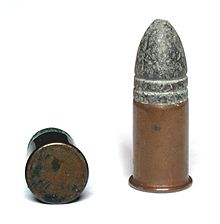.56-56 Spencer
| .56-56 Spencer | |
|---|---|
| general information | |
| caliber | .56-56 Spencer |
| Sleeve shape | Rim cartridge |
| Dimensions | |
| Sleeve shoulder ⌀ | 14.25 mm |
| Sleeve neck ⌀ | 14.25 mm |
| Floor ⌀ | .550 inches 14 mm |
| Cartridge bottom ⌀ | 16.30 mm |
| Sleeve length | 22.62 mm |
| Cartridge length | 42.24 mm |
| Weights | |
| Bullet weight | 23 g |
| Powder weight | 2.8 g |
| Technical specifications | |
| Speed v 0 | 370 m / s |
| Bullet energy E 0 | 1,525 y |
| Lists on the subject | |
The .56-56 Spencer was a rifle cartridge used in the North American Civil War .
history
Developed the cartridge for when was Spencer Repeating Rifle Company made in Boston, Massachusetts Spencer rifles and carbines, of which 1863 more than 100,000, of which 50,000 carbines to the infantry, the cavalry and the navy of the Northern States were delivered.
In addition to the Spencer rifle, other weapons used by Northern troops such as the Ballard rifle and Joslin carbine also used this ammunition.
technology
The designation .56-56 is unusual, with American cartridges such as the .50-70 Musket and the .45-70 Government , the front number was used to designate the caliber; the other number was the weight of the gunpowder charge. In contrast, the Spencer cartridge was officially designated as No. 56 or .56-56 , the two numbers referring to the front and rear case diameter of 14.2 mm, indicating that it was a cylindrical case.
The .56-56 cartridges had copper cases. They and their later variants were rimfire cartridges , which in the Spencer rifle, unlike the .44 Henry cartridge, which was struck on both sides in the Henry rifle, were struck only on one side. The ogival bullet of the .56-56 used in the Civil War weighed between 350 and 360 grain and had 3 grooves. Since Spencer ammunition was manufactured by different manufacturers during the Civil War, deviations between individual cartridges were common, the bullet diameter was between .54 and .555 inches (13.7 - 14.1 mm) and the bullet weight between 350 and 360 grains (22.7 - 23.3 g) and the black powder charge between 42 and 45 grain (2.7 - 2.9 g). With the Spencer rifle with a 30-inch barrel (76.2 cm) in the nominal caliber .52, a muzzle velocity of 370 m / s was achieved, with the carbine (barrel length 22 inches, 56 cm) it was somewhat lower. Thus, the Spencer ammunition was inferior to the other ammunition used in the Civil War, with the exception of the .44 Henry cartridge, in terms of firing range and penetration power .
Since the Spencer rifles were multi-loaders and the carbines given to the cavalry were used at shorter distances, the poor ballistic performance did not play a major role.
Later use
After the Civil War, the Springfield Armory (Massachusetts) replaced the barrels of 11,000 Spencer carbines with .50 caliber barrels. The .56-52 or .56-50 caliber cartridges developed for this purpose were interchangeable. Except for a minor difference in the diameter of the case base, they were identical. Both fired bullets weighing 350 grains. These cartridges were used in the weapons that were converted in this way during the Indian Wars until they were replaced by the Springfield Model in 1873 .
For hunting use of modified Spencer rifles, the cartridges were offered under the designation .56-56 Spencer on the civilian market in the USA until the 1920s. In addition to the .56-52 and .56-50 ammunition, cartridges in caliber .56-46 (11.6 mm) were also produced; they fired a projectile with a weight of 320 to 330 grains and, like the .56-52- and .56 50 cartridges have a sleeve that tapers slightly towards the front.
literature
- Norm Flayderman: Flayderman's Guide to Antique American Firearms . Krause Publications, Iola, WI 2001, ISBN 0-87349-313-3 .
- Marfe F. Delano, Barbara C. Mallen: Echeos of Glory, Arms and Equipment of the Union . Time Inc. Book Company, New York, NY 1991, ISBN 0-8094-8855-8 .
- Barnes Frank C .: Cartridges of the World . DBI Books, Northfield, IL 1972, ISBN 0-695-80326-3 .
